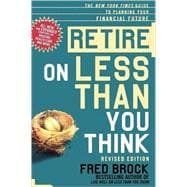
Note: Supplemental materials are not guaranteed with Rental or Used book purchases.
Purchase Benefits
What is included with this book?
| Preface | p. ix |
| Do You Really Want to Retire? | p. 1 |
| What the Experts Say You Need versus What You Really Need | p. 28 |
| Cutting Back and Simplifying Your Life | p. 53 |
| Where Will You Live? | p. 70 |
| Key No. 1: Your House | p. 95 |
| Key No. 2: Your Health Insurance | p. 117 |
| Key No. 3: Your Unexpected Assets | p. 155 |
| Social Security: Count on It | p. 168 |
| Putting It All Together | p. 187 |
| Resources | p. 201 |
| Index | p. 209 |
| Table of Contents provided by Ingram. All Rights Reserved. |
The New copy of this book will include any supplemental materials advertised. Please check the title of the book to determine if it should include any access cards, study guides, lab manuals, CDs, etc.
The Used, Rental and eBook copies of this book are not guaranteed to include any supplemental materials. Typically, only the book itself is included. This is true even if the title states it includes any access cards, study guides, lab manuals, CDs, etc.
Excerpted from Retire on Less Than You Think: The New York Times Guide to Planning Your Financial Future by Fred Brock
All rights reserved by the original copyright owners. Excerpts are provided for display purposes only and may not be reproduced, reprinted or distributed without the written permission of the publisher.